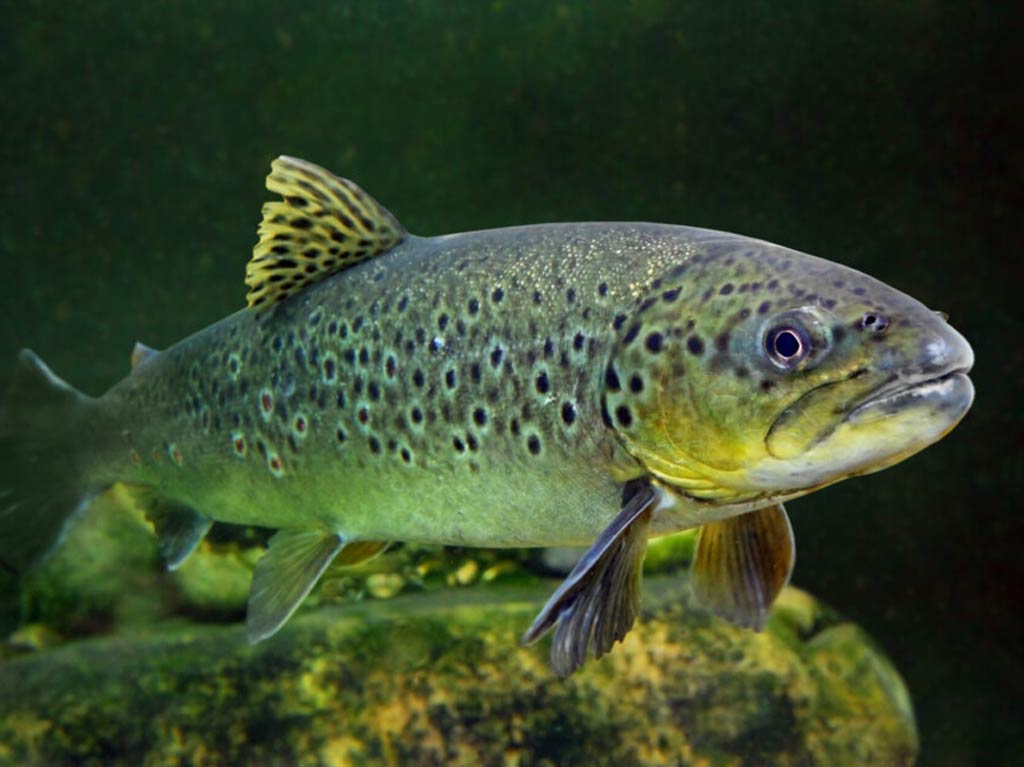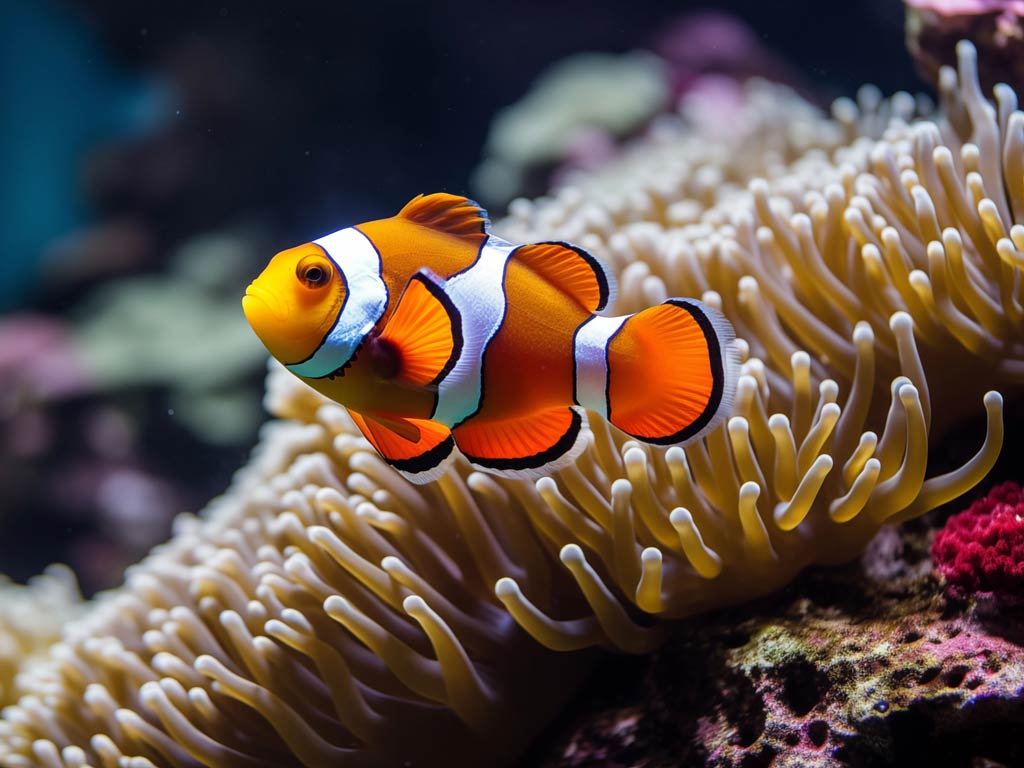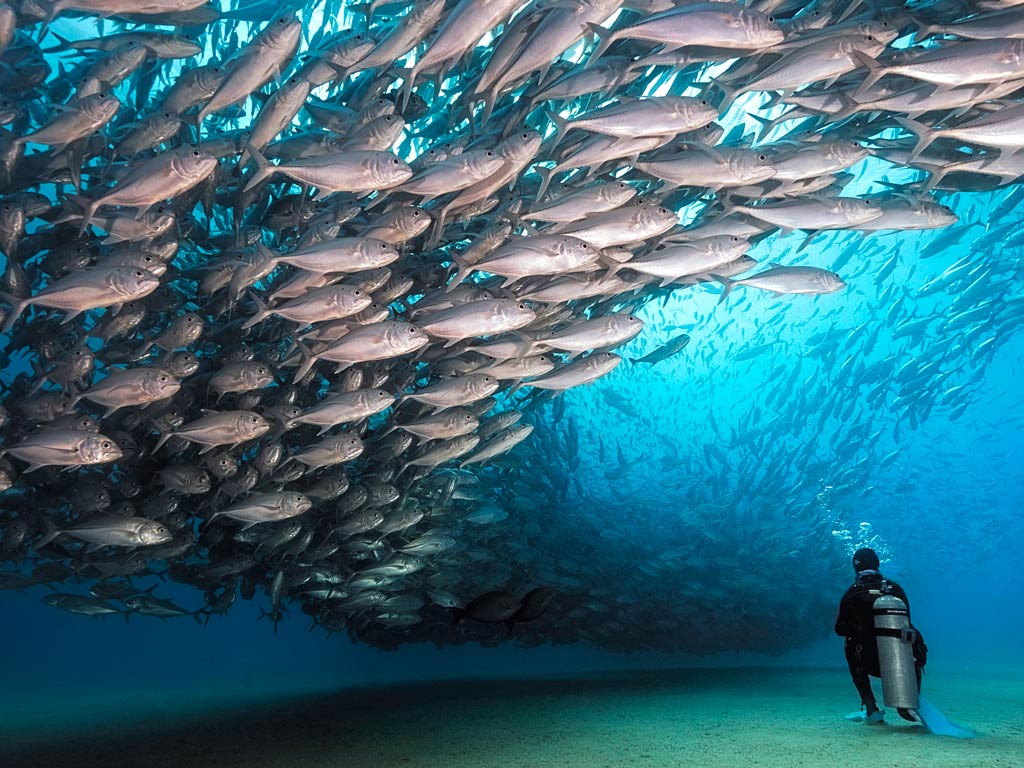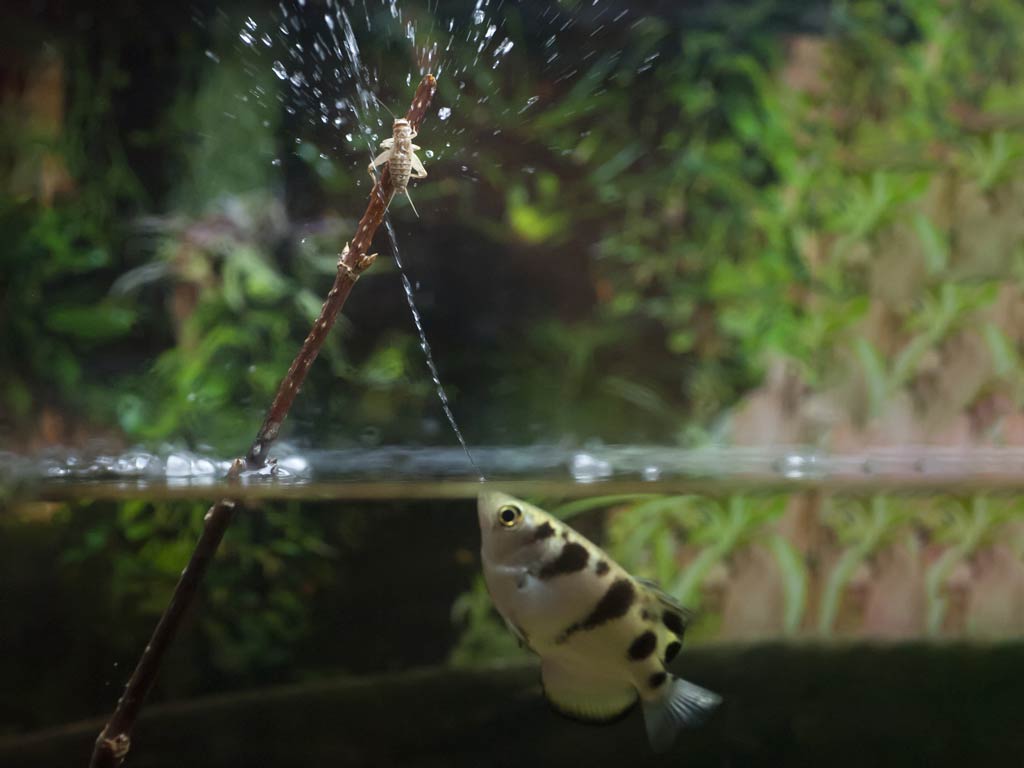If you’re irrevocably hooked on all things fish, this article is for you! We’ve carefully curated a list of the most interesting and fun facts about fish we could think of. From quirky habits to mysteries surrounding how they age, live, breathe, and talk, we’ve reeled in answers to some of the questions you were most curious about.

We know you probably have more questions on your mind. But here’s the cool part – you can always ask us! We’re happy to dive into your fish dilemmas. Plus, we’re counting on our fish fandom to join the conversation and share silly information they’ve been keeping for themselves – until now.
So, enjoy the article and don’t hesitate to join the never-ending fun fish facts conversation in the comments section below this article.
1. How many fish are there in the world?
Let’s kick off our fun fish facts article with one of the most commonly asked questions out there – how many fish and fish species are there?

While it’s extremely difficult to provide an exact number, we know that scientists have identified over 35,000 different species of fish so far. These include both freshwater and saltwater fish, ranging from tiny minnows to massive Sharks.
When it comes to the total fish population, these numbers are far less precise. Due to various environmental changes, fluctuations in reproduction, natural predators, and human impact (including fishing), it’s hard to tell how many fish there are. What we can do, however, is give you an estimate. It’s thought that there are around 3.5 trillion fish in the world. That’s roughly 450 fish per person!
2. Can fish walk?
Yes, fish can walk, and it’s more common than you probably think. Scientists believe that there are at least 11 fish species in the world that have the ability to walk. The majority is limited to the seafloor, but some can also stroll on land above the water.

Instead of swimming, species like Handfish and Sea Toad use their funny-shaped fins to move along the bottom. These bottom-dwellers live on the seafloor and never venture out of the water. Mudskippers, on the other hand, are quite famous for their land-walking skills. The secret to their smooth transition from water to land is mud. It keeps them cool and moist, and allows them to easily move around – even jump!
3. Can fish fly?
If some fish can walk, why can’t others fly? Jokes aside, the notion that some fish can fly is only partly accurate. Namely, there are species with wing-like fins that appear to be gliding above the water, but they aren’t actually flying. The most famous example is the Flying Fish.

Flying Fish launch themselves out of the water, spread their wings, and travel above the surface, looking airborne. Having in mind that they can pass up to 650 feet like that, it’s no wonder you’d think they have bird-like abilities. But the truth lies somewhere in between. Sure, they spread their fins to catch air, but they actually propel themselves with their tails. It’s the rapid movement of the tail against the water that enables them to “fly.”
4. Can fish breathe air?
Now that you know about Mudskippers, the answer to this shouldn’t come as a surprise. This fun fact is true – some fish species can breathe air. Mudskippers, for example, spend a lot of their time on land, so naturally their bodies have adjusted to their lifestyle. They can breathe air through their skin and absorb oxygen through their mouths. But they aren’t the only fish to breathe air.

Some creatures, like Lungfish, literally have lungs! That’s right, these unusual freshwater residents are more closely related to us than their underwater counterparts. Others, such as aquarium fish Bettas, use special labyrinth organs to extract oxygen. The list of air-breathing fish goes on to include Tarpon, Bull Sharks, and even Catfish.
5. Can fish sing?
Maybe not in a way humans or birds can, but fish most certainly can produce various sounds we can interpret as singing. Grunting, croaking, humming, drumming… Fish have their own acoustic language they use to communicate different things, from courting to warning.

Through their vibrating swim bladders, Red and Black Drums create the low-pitched drumming sounds they’re named after. Atlantic Croaker, Toadfish, and some Catfish can also brag about singing abilities. But the award for the best singers goes to Plainfin Midshipmen. They produce continuous humming melodies that remind us of a chorus of Buddhist monks. These meditative chants are so loud, they’re easily heard by people.
6. Can fish create art?
Believe it or not, fish are creatures with many talents. Much like with singing, fish are also capable of creating mesmerizing shapes that are nothing short of artistic. Take Pufferfish, for example. Pufferfish males design intricate sand patterns to impress females. They practically build art masterpieces as part of their mating ritual. They even decorate their sand sculptures with shells. How’s that for a fun fish fact?
7. Do fish have any funny habits?
Besides singing and sculpting, fish have other quirky habits, too. Some species, like Parrotfish, love a good night’s rest. But the funny thing is that their idea of a safe and sound sleep is a bed made out of mucus.

Every night, Parrotfish make mucus sleeping bags to spend the night in. There are many theories why they do this, but it’s most likely a protective layer against predators and other types of damage. And Pearlfish? They have the habit of seeking shelter in the butts of Sea Cucumbers. You read that right – they hide inside these poor creatures!
8. Do fish mate for life?
By now, you’ve realized that fish can court, but can they have their “happily ever after” with a single partner? In some cases, yes. Several species of fish practice monogamous relationships, but only a few form lifelong bonds. Fish that are believed to mate for life include some species of Seahorses, Butterflyfish, and French Angelfish. What a cute, fun fact about fish species!
9. How long can fish live?
The answer to this question varies tremendously depending on the species. Killifish, for example, are considered the fish with the shortest lifespan – a maximum of 9 months. Goldfish, meanwhile, live 10 years on average. But Tish, the world’s oldest Goldfish, lived 43 years!

Some fish, such as Alligator Gar, are called “living fossils” because they’ve been around for a long period of time, and they can also live more than 90 years. But the absolute record-holders are Greenland Sharks. Their average lifespan is around 300 years!
10. What is the smallest fish?
There’s a debate over the smallest fish in the world. Apparently, the disagreements revolve around the definition of “small.” But we’re putting this tiniest crown on Indonesian Carp (Paedocypris progenetica). These miniature royals grow to a maximum size of 0.39 inches, which is about the length of a grain of rice. They’re the smallest fully developed fish and, as such, deserve to wear this title.
11. What is the largest fish?
The largest living fish in the world is the Whale Shark. Even though they’re Sharks, they’re completely harmless to humans. These gentle giants can grow 40 feet on average and weigh up to 20 tons. That’s a fish as big as a bus!

And the largest accurately recorded Whale Shark was even more impressive. That leviathan was found in the Indian Ocean in 2001 and measured 61.8 feet long! A less fun fish fact is that these majestic creatures are listed as endangered.
12. Do fish sleep?
If you remember what we said about Parrotfish, then you’re familiar with the fact that fish have “sleeping” habits. However, fish do not sleep. Well, at least not in the way we humans do. In other words, fish don’t fall asleep with their eyes closed. Instead, they rest by slowing down and preserving energy by floating or curling up in safe and cozy places. And this almost motionless state can be interpreted as restorative in the same way that sleep is for people.
13. Do fish pee?
Absolutely! But here’s the real fun fact – saltwater and freshwater fish pee for different reasons. Saltwater fish live in a salt-saturated environment, so they have to pee to get rid of the excess salt. They do this through special gills that help them regulate their hydration levels.

Freshwater fish have the opposite problem. Their bodies are saltier than their surroundings. Therefore, they pee to get rid of the excess water. In fact, to keep themselves from bursting, they almost constantly pee!
But there’s more. Fish also use their urine to communicate with other fish by sending chemical signals and fertilize algae and corals. Who knew fish pee was so interesting?
14. Can fish change gender?
As with many of our fun fish facts, the answer is – yes. And it’s more common and funnier than you probably think. More than 500 different species have these gender-bending abilities, including Groupers, Clownfish, and Wrasse. But why do they do this?

The main reason is reproduction, but there are also cases of changes due to the loss of the dominant male or female in the group. Most species swap gender once, but there are fish like Gobbies that can switch roles multiple times!
15. Can fish recognize human faces?
Research led by Dr Ulrike Siebeck in 2016 demonstrated that fish are able to distinguish human faces. During the study, they trained Archerfish to respond to a particular face. The fish were rewarded each time they picked the correct answer. And when they were given 44 new faces, they were able to identify the exact face they were trained to with an average accuracy of around 84%! So, it’s safe to say that fish can recognize human faces.
Want to see something even sillier? Check out how Archerfish actually picked the faces. Fun facts about fish at their finest.
16. Can fish live at depths where humans would never survive?
How do depths of nearly 28,000 feet sound to you? We’re asking because this is where a species of Snailfish was found thriving in 2022 – and this is deeper than any other fish recorded! To illustrate how extreme this sunless abyss is, imagine more than 15 Empire State Buildings piled one on top of the other beneath the ocean’s surface.

Humans don’t have the slightest chance of surviving there. Our lungs would be crushed almost instantly. But Snailfish don’t have any air pockets or gas cavities, so the horrid pressure doesn’t affect them.
17. Can fish produce electricity?
We know that several fish species can emit light. These include Anglerfish that use bioluminescence to lure prey and Pinecone fish that rely on special organs called photophores to glow. But what about actual electricity?

Electric Eels are known for their ability to produce electricity. They can generate more than 800 volts, which is enough to light up several LED bulbs for a few seconds. It’s also the highest voltage an animal can release. Elephantnose Fish are less famous and not as powerful as Electric Eels, but equally capable of electric discharges. Both species use their incredible skills to hunt and stun their prey.
18. What is the fastest fish?
Let’s get straight to the point – Sailfish are widely regarded as the fastest fish in the world. For a long time, Black Marlin was perceived as the winner of this category, but recent findings suggest it’s actually Sailfish. This topic, however, remains a never-ending source of debate among anglers and marine biologists alike. We’ve even dedicated an entire article to the most famous speedsters in the underwater world!
19. How do fish hunt?
Have you ever wondered how fish catch their food? Besides Anglerfish and Eels that use light and electricity to hunt, here are two more funny examples. Archerfish, famous for recognizing human faces, hunt by spitting – the same and quite precise method they used to tell humans on the computer apart.

The second, quite silly approach to hunting is playing dead. Yellowjacket Cichlid pretend to be dead, so that they can attract smaller fish to feast on their bodies. And when their guests don’t suspect anything, they spring back to life and snatch them!
20. Can fish fart?
We left the best for last. One of the funniest fish facts is that fish can fart. Well, they poop, why wouldn’t they fart, too? However, breaking wind in fish isn’t about digestion as it is in humans. It’s more a form of communication and buoyancy control. Some species, like Herring, release gas from their swim bladders to send messages (and tiny bubbles). Others, such as Sand Tiger Sharks, emit gas to adjust their buoyancy and sink more easily.
More Fun Facts about Fish? Ask or Tell Us!
As you can see, the underwater world is an endless source of inspiration and fun information about fish species. We’ve shared our top picks with you, but we’re curious to see if you have more questions or facts of your own to share with us. So, go ahead, hit that button below, and join the fun fish facts conversation.
What’s your favorite fun fish fact from the list? Do you have more interesting fish-related questions? Or perhaps fun facts? Share your thoughts with us in the comment section!
